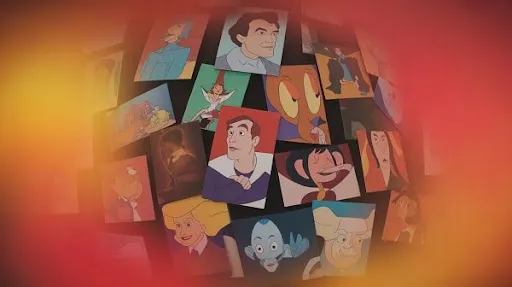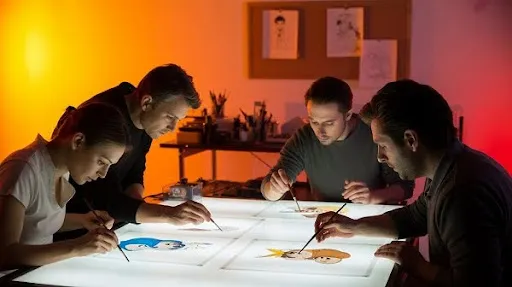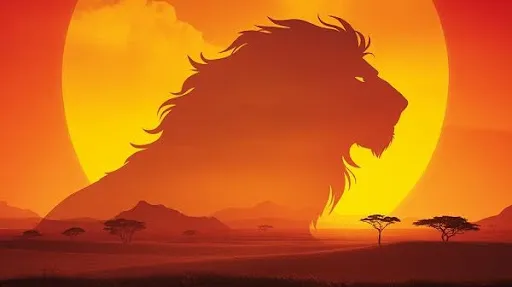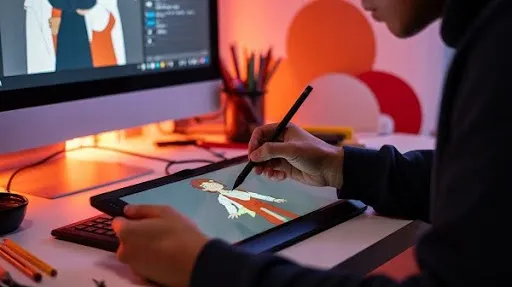Think about it for a second long before Mickey Mouse was whistling at the wheel or kids were glued to Saturday morning cartoons, people were already chasing the dream of making drawings move.
Sounds obvious now, but in the early 1800s? It wasn’t “art” or “film.” It was more like a parlor trick. A curiosity. Something you’d pull out at a party to make folks go, “Wait… how did you do that?”
Imagine it: scraps of paper covered with doodles, cylinders with holes cut into them, discs spinning in front of mirrors. Nothing polished. No movie studio in sight. Just inventors, kids, and hobbyists fiddling around because they were curious.
And every now and then, one of those contraptions worked. A flat drawing jumped into motion, and suddenly, people were swearing it felt like magic.
Funny thing is, it didn’t start in glamorous studios or theaters. There weren’t red carpets, producers, or box office numbers. These experiments were born in living rooms, classrooms, and even kitchen tables. Curiosity not money was the spark.
Early Toys That Fooled the Eye
One of the first big “wow” moments came in the 1830s with the phenakistoscope. Spin the disc, look in a mirror, and still drawings suddenly danced. Not gracefully, but enough to trick the eye.
A little later came the zoetrope basically a drum with slits. Drop in a paper strip, give it a whirl, and boom, a tiny moving loop. Primitive? Absolutely. But for a kid in the 19th century, that was their version of TikTok.
And then there’s the flipbook, the classic everyone knows. If you’ve ever sat in math class flipping the corner of a notebook, you know the rush. Your stick figure running, or maybe a flower blooming, page by page. Crude, yes, but powerful.
That little discovery proved something important: our brains are eager to believe in motion. Without that illusion, 2D animation services might never have grown past being a party trick.
Silent Screens, Characters With Personality
When film cameras finally came along, animators had to ask: “Can we take these parlor toys and make them work on a big screen?” At first the results were clunky jerky motions, repetitive cycles, almost hypnotic but not very entertaining.
Then came Winsor McCay with Gertie the Dinosaur (1914). And that was different. Gertie didn’t just move. She had attitude. She stomped, bowed, even seemed to listen to McCay during live performances.
For the first time, audiences weren’t just seeing motion. They were meeting a character. That’s the leap from “look, it moves” to “hey, this creature has personality.” That leap is what made animation storytelling, not just spectacle.
Cel Animation: The Breakthrough
Now here’s the thing. Drawing every frame? Absolute nightmare. Imagine sketching out every flick of a hand or twitch of an eyebrow. Hours gone for just a few seconds of footage.
Enter cel animation. Artists drew characters on transparent sheets, layering them on top of painted backgrounds. Suddenly, you didn’t have to redraw everything just the parts that actually moved.
It wasn’t just efficient. It gave animations a clean, colorful look that became the standard for decades. For the first time, you could balance quality with speed. That changed everything.
Disney Changes the Rules
Then, of course, Disney arrived to rewrite the rules. Steamboat Willie hit screens in 1928 and stunned audiences. Mickey wasn’t just moving; he was whistling in sync with the soundtrack. Sound and picture working together a revelation.
Disney wasn’t done. Less than a decade later came Snow White and the Seven Dwarfs (1937). A feature-length animated film. At the time, people thought Walt had lost his mind. Critics even called it “Disney’s Folly.” But when the movie premiered, it blew everyone away.
Suddenly, animation wasn’t filler before the “real” movie. It was the movie. And it wasn’t just about comedy or tricks. Animation could carry drama, emotion, heartbreak the whole package.
Rivals Join the Party
Of course, once Disney cracked the door open, the competition came rushing through. Warner Bros. gave us Bugs Bunny, Daffy Duck, and Porky Pig. MGM brought Tom and Jerry to life. Fleischer Studios gave us Popeye and Betty Boop.
The difference? Disney was building fairy tales; Warner and the others were doubling down on comedy, slapstick, and timing. Their characters weren’t just movie reels. They became cultural icons plastered on lunchboxes, radios, comic strips, and later, TV.
That era proved something big: 2D animation wasn’t one-note. From heartwarming princesses to wise-cracking rabbits, it was flexible enough to fit any tone, any audience.
TV and the Rise of Limited Animation
By the 1950s, television was in every living room, and studios had to adapt. The problem was, TV needed content fast and cheap. Enter limited animation fewer drawings, recycled backgrounds, repeated cycles. Not perfect, but fast.
Hanna-Barbera nailed the formula. The Flintstones, Yogi Bear, Scooby-Doo none of them had Disney’s lush detail, but kids didn’t care. They tuned in anyway, week after week.
Critics weren’t always kind about the corner-cutting, but TV proved a point: animation didn’t need perfection to connect. Sometimes, rough-and-ready was enough. And honestly, it gave those shows their charm.
The Disney Renaissance
Jump ahead to the ’80s. Disney was floundering. The spark seemed gone. Then, out of nowhere, came the Disney Renaissance.
The Little Mermaid (1989), Beauty and the Beast (1991), Aladdin (1992), and The Lion King (1994) were all released back-to-back and were massive successes. Each film mixed traditional hand-drawn animation with new technology and catchy tunes.
Audiences fell in love all over again. Those films weren’t just movies; they were cultural moments. That era reminded everyone: the magic of 2D animation hadn’t disappeared. It was just waiting for the right spark.
The Digital Shift
By the late ’90s and early 2000s, computers were sneaking into the animation process. At first they just made coloring and layering faster. But then came Adobe Flash.
Flash changed the rules. The animation world underwent a massive change. Instead of explosive budgets from Disney or Warner Bros. Studios, all you needed was a computer, an internet connection, and a good amount of patience.
The internet was filled with sites like Newgrounds, which were populated with amateur short animations. Some clunky, some hilarious, some surprisingly brilliant.
It was a turning point. For the first time, the future of 2D animation wasn’t locked behind studio walls. It was open to anyone willing to try.
The New Millennium: 2D Animation Reinvented
By the 2000s, you might have thought 2D animation had run its course. It had already lived through toy gadgets, Disney’s golden years, Saturday morning marathons, anime waves, and even a massive comeback in the late ’80s and ’90s. What else could it do? Turns out plenty. The digital age showed up, and everything flipped again.
The cels and paint that powered animation for almost a century? Gone. Suddenly, it was styluses, tablets, and glowing monitors. Instead of ink drying on plastic, artists worked with vector lines, layers, and undo buttons. Some old-school animators weren’t thrilled, but the change wasn’t optional it was the new reality.
Meanwhile, 3D was stealing the spotlight. And with Pixar’s Toy Story shocking everyone in 1995, followed a few years later by DreamWorks’ success with Shrek, it seemed the world was set on a 3D animation services craze.
However, a huge wave of fans and creators remained convinced that computer-generated animations could never match the warmth of hand-drawn animations. Rather than fading away, 2D adjusted and found new tricks.
Digital Tools Take Over
Toon Boom, TVPaint, Adobe Animate (basically Flash all grown up) these programs became the new pencil and paper. Animators could sketch, clean up, and color faster than ever. And for the first time, you didn’t need a giant studio behind you.
A teenager with a decent laptop could make something watchable. That shift took power out of Hollywood’s hands and spread it across the internet.
TV Keeps 2D Alive
And in the midst of all the 3D animated films and blockbusters being released, 2D animation was still a must on TV. Channels like Nickelodeon and Cartoon Network released 2D animated shows that became the foundation of everyone’s childhood: Dexter’s Laboratory, The Powerpuff Girls, SpongeBob SquarePants, and Avatar: The Last Airbender.
Each one showed off a different strength of 2D from absurd comedy to surprisingly deep storytelling.
Japan set the rest of the world on fire with anime. Countries outside of Japan began receiving the shows Naruto, One Piece, and Bleach through cable TV, DVDs, and eventually streaming services. Animation was suddenly not only a “kids’ thing” anymore.
It dealt with grief, love, war, and even politics. That mix of Eastern and Western influence redefined what people thought cartoons could be.
The Internet Revolution
While studios stepped back, the web blew things wide open. Newgrounds, early YouTube suddenly, Flash animators were everywhere.
Remember Happy Tree Friends? Or Eddsworld? Or those endless stick-figure fight clips? They weren’t polished, but that didn’t matter. They were funny, weird, sometimes brutal, and definitely addictive.
For the first time, a solo creator in their bedroom could get as much attention as a studio short. That democratization rewired the whole industry. Animation wasn’t just Saturday mornings anymore it was anytime, anywhere.
Streaming Brings 2D Back
By the 2010s, streaming changed everything again. Netflix, Disney+, Hulu, HBO Max content could go global in a single drop. And 2D got another wave of love.
Netflix bet big on anime and original projects like Castlevania and Kipo and the Age of Wonderbeasts. Even hybrid hits like Arcane leaned heavily on 2D-inspired design. And Disney, testing the waters, gave us The Princess and the Frog in 2009 proof that hand-drawn animation could still shine, even if it didn’t kickstart a full return.
Tools of Today
Modern animators have a toolkit older generations couldn’t dream of:
- Toon Boom Harmony – studio standard.
- TVPaint – perfect for traditional frame-by-frame.
- Adobe Animate – versatile, especially online.
- Krita – open-source and gaining fans fast.
Instead of choosing “old school” or “digital,” most projects blend both. You’ll see rigged animation mixed with hand-drawn flourishes, creating something that feels both efficient and personal.
Why 2D Still Matters
Technology aside, 2D survives because it creates cultural anchors. Think:
- Mickey Mouse still Disney’s mascot.
- Bugs Bunny sarcasm that never gets old.
- Naruto and Goku global icons for multiple generations.
- SpongeBob honestly, one of the most recognizable faces on Earth.
These characters aren’t just cartoons; they’re part of how people grow up, joke, and even see themselves.
Looking Ahead
So where does 2D go from here? It’s not disappearing. 3D might dominate the box office, but 2D continues to thrive in TV, anime, indie projects, and online spaces. And with new tech like VR and AR, it might find completely new ways to exist.
The truth is, audiences never stopped caring. Some watch because of nostalgia. Others because they’re just discovering it fresh. Either way, the appetite is bigger than ever and 2D isn’t leaving the table anytime soon.
Frequently Asked Questions
What’s the biggest difference between 2D and 3D animation?
2D is flat drawings brought to life. 3D builds digital models in a 3D space. Both tell stories differently, but 2D usually has more stylistic freedom.
Is 2D still around today?
Yes. From anime to Netflix originals to indie shorts, 2D is everywhere.
Why did Hollywood walk away from 2D?
Because 3D made more money at the time. Pixar proved it, and studios followed.
What’s the best beginner software?
Adobe Animate and Krita are good entry points. Pros use Toon Boom Harmony or TVPaint.
Where is 2D headed?
Expect more growth in streaming, anime, and indie spaces. Digital tools will keep it alive — just in new forms.
Conclusion
The history of 2D animation isn’t neat. It’s more like a rollercoaster peaks, dips, and surprising comebacks. From spinning toys to YouTube shorts, from Disney classics to viral web memes, 2D keeps reshaping itself to fit the moment.
And that’s why it’s still here. With just a few lines and colors, it can capture imagination in ways no other medium quite matches. Hand-drawn, digital, hybrid whatever form it takes, 2D animation remains one of the most resilient and beloved storytelling styles in the world.
If you are looking for flawless 2D animation services, then contact Prolific Studio. We are one of the top animation studios in Washington, DC, delivering top-notch animation at market-competitive rates.
Related articles:










